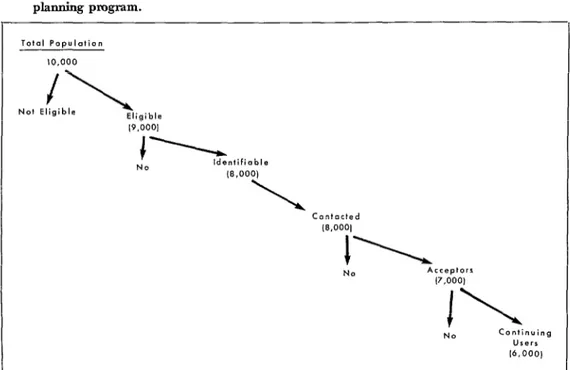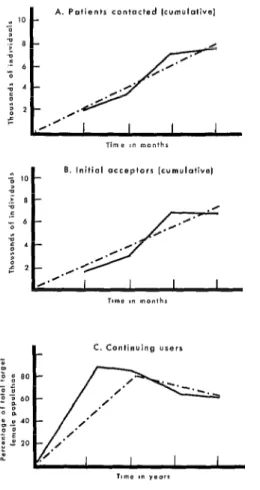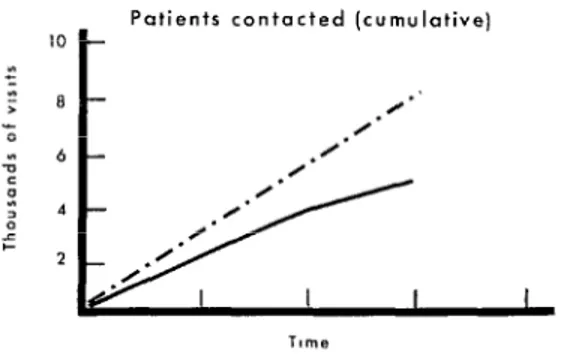INTERMEDIATE OBJEC’ITVES FOR THE MONTIORING
OF FAMILY PLANNING SERVICES’
Char A. Chrzantes2
Intermediate objectives are imfiortant for monitoring and
evaluating the progress of a program in its early stages. The advantages, requirements, and limitations of such targets as
managerial tools within family planning programs are
discussed.
Introduction
One of the responsibilities of a family
planning service program is to document
and analyze the results of its activities.
Scientific data are essential in order to
demonstrate the validity of the work done,
justify the utilization of resources, and
stimulate increased support (social and po- litical as well as financial) for the program.
Evaluation ensures the undertaking’s sur-
vival and continuation. It is a necessary mechanism and a useful tool, and it must be an integral part of a program’s development and operation.
Evaluation is difficult during the early stages of an activity, since not enough time has elapsed for the desired results to occur. Indicators other than the ultimate targets
are needed. The present paper addresses
this problem and proposes the use of
intermediate objectives for early program
evaluation and monitoring. An “interme-
diate objective” may be regarded as a stra- tegic position or condition that needs to be
achieved before the ultimate goal can be
‘Also appearing in Spanish in I301 Of Sanit Panam
83 (5 ), 197’7.
%chool of Public Health and Tropical Medicine, Tulane University, New Orleans, Louisiana, U.S.A.
attained. “Monitoring” is understood here
to mean those activities directed toward
keeping track, regulating, and controlling
the progress of a program as it moves
toward the fulfillment of its stated objec- tives.
Discussion
A family planning program is regarded
here as a mechanism for the provision of
information, education, and services aimed
at guiding individual or community be-
havior with respect to fertility. This defi- nition offers a frame of reference within
which the factors that bear on program
effectiveness can be considered.
In the first place, there is the program’s capacity to affect attitudinal and behavior- al change. Since one of its purposes is to
motivate the individual or community to
adopt a specific pattern of behavior, the mechanisms that it uses in order to inform and to educate are indispensable elements in its effectiveness (1).
Secondly, if it is to promote and sustain
the expected behavior, the program must
be able to enlist acceptors and keep them within its ranks. In other words, it must have a system whereby services are offered
to the individual and the community (1, 8.
Thus, both the capacity to induce
changes in behavior and the capacity to
render service are directly related to the program’s impact (3, 4, 5) and should be in- cluded as critical points in the evaluation strategy.
Reynolds has referred to program evalu- ation as “a process that includes measure-
ment of goal achievement, feedback of
information for adaptive decision-making, and examination of a wide variety of proc- esses to determine why and how a program was or was not successful” (6). Accordingly, the strategy for evaluating a family plan- ning program should call for both retro-
spective measurement and the assessment of
ongoing activities.
The question of whether or not the pro-
gram has been successful in achieving
changes in the fertility status of the target
population could be termed “ultimate pro-
gram impact.” However, this can only be
assessed after there has been sufficient operational time and enough activities have been carried out to have an effect on the “target” population. It is an accepted fact
that fertility changes in a community
cannot be measured until a program has
been in operation for three to five years (3).
Hence such changes in the community
cannot be analyzed or serve as a basis for
early management and operational deci-
sions.
On the other hand, it is possible to con- duct a continuing assessment of whether or not the program is advancing in line with the anticipated trends and therefore meet- ing its intermediate objectives. However, this calls for the definition of measurable targets, correlated in terms of a cause-and- effect relationship.
For example, the ultimate objective of a
program might be to reduce maternal and
infant morbidity and mortality in the com-
munity through increased intervals be-
tween pregnancies and lower rates of
fertility during the high-risk maternal
years. To achieve this goal it will be neces- sary first to identify the individuals to be the target (intermediate objective). Second, the recruited population will be expected to adopt a specific pattern of behavior,
namely utilization of effective methods of
fertility regulation (intermediate objec-
tive). Third, the enrolled population will be required to sustain the adopted behavior during a specific period of time (interme-
diate objective) in order to achieve the
desired program impact.
If this sequential scheme is to be applied effectively, the objectives must be expressed
in measurable terms that specify the
number of individuals to be affected and
the time it will take to achieve a specific
status. Thus the foregoing intermediate
objectives might be formulated as follows:
l Identification of 80 per cent of the po- tential acceptors of reproductive age in the
female population (10,000 women) within
three months;
l Establishment of contact with 100 per cent of the identifiable female population within one year of program operation:
l Recruitment of 80 per cent of the
identifiable female population within one
year of program operation:
l Provision of services to 80 per cent of
the identifiable female population within
one year of program operation; and
l Maintenance of continuous participa- tion on the part of 60 per cent of the identifiable female population for a period of two years or more.
Figure 1 depicts these sequential targets schematically.
The ultimate objective, in turn, might
be broken down into the following specific targets for a total five-year period:
l Achievement of pregnancy intervals of
two years or more by 60 per cent of the
Figure 1. Sequential, specifically stated intermediate targets in a hypothetical family planning program.
Total Pooulafion
-1
l0.000
-l
No! Eligible
Eligible l9.0001
l Increase of the mean age at first
pregnancy to 18 years of age or more in the identifiable female population.
This approach, perhaps somewhat sim-
plistic, is based on the assumption that
intermediate objectives have a cause-and-
effect relationship with regard to the
ultimate objectives.
The utilization of intermediate objec-
tives provides the opportunity to develop
mechanisms for continuing analysis and
also techniques that will permit monitoring to begin early in the operational phase of the program, both of which are useful tools
in decision-making. The approach also
helps in the mapping out of expected pro- gram progress, in this way becoming an in- tegral part of the evaluation effort. Thus its value is not limited to the early stages of program operation.
Intermediate objectives need to be based realistically on the service capacity assumed
for the program. Accordingly, estimates of
such factors as personnel service capacity, facilities, patient load, service time, and
patient flow need to be built into the
design. Once this is done, the intermediate objectives can serve as parameters against
which the program’s performance is com-
pared (4, 5).
Figure 2 illustrates an example of inter-
mediate target fulfillment in a highly
efficient operation. Figure 3 offers an
opposite example, in which budget over-
runs, unmet objectives, or system overloads will be the end result unless appropriate
managerial and operational decisions are
taken promptly.
While intermediate objectives seem to be a simple and useful tool for the monitoring of family planning services, certain require- ments must be met.
l First, the target population must be
defined numerically and the time frame
decided on.
Figure 2. Example of fuIfiIhnent of intermediate objectives in a hypothetical family planning program that is being efficiently run.
C. Continuing users ;
service activities. It should specify patient
load, personnel performance, and service
capacity .
l Third, a record system must be estab-
lished and the procedures spelled out
whereby information about service utiliza- tion is to be retrieved. Also, there must be a system for individual patient identifica- tion.
Since these requirements are usually met
by most family planning programs, the
implementation of a patient service moni- toring system should be a feasible task for the interested administrator.
D. Clinic Visits [cumulative)
There are, however, changing circum-
stances that need to be taken into account. For example, the target population is never
entirely stable. While some women are
entering the fertile age range, others are leaving it. Also, people move in and out of
the community. At the same time, socio-
political changes may occur, such as
legislation in regard to family planning, that will greatly alter the nature of the target population. Hence it is necessary to review the situation from time to time so
that the intermediate objectives can be
Figure 3. Example of failure to fulfill interme- diate targets in a hypothetical family planning program that is destined to have problems in meeting its &mate objectives.
‘O f-
Patients contacted (cumulative)
Tnme
Initial and total clinic visits (cumulative]
/’
/’
.
&
Initial
I /
,
Time
. -. - Pr.,grammed hrget - Actual performance
Program efficiency needs to be analyzed
in terms of both services rendered-mea-
sured by the number of women affected in
a given time span-and cost. What is the
minimum cost at which the desired services
can be provided? Naturally, costs vary
from program to program. They depend on
the particular activities contemplated, the
scope of services offered, etc., and they also depend on the specific characteristics of the
population. In particular it has been
argued that services to groups that are
socioeconomically less advantaged require
additional education efforts that make
them more costly (Figure 4). Hence each
program must be analyzed on the basis of
indicators which ultimately will establish its own pattern of efficiency. Once such a
pattern has been standardized, activities
and costs can be analyzed periodically and
continually, and this process can then
become a true mechanism for monitoring the efficiency of program operation.
Figure 4. Cost of a family planning program by category of expenditure and by socioeconomic level of patients served. (Unpublished data based on exfieriences in the Louisiana Family Planning Program.)
Servare
Since progress during the early stages of a Family planning programs suggest a series of
program cannot easily be measured in terms of useful intermediate objectives that have a clear
vide for a numerical definition of the target allowance should be made for periodic review population; a given time frame; a service design and adjustment in light of modifications that which takes into account patient load, personnel are bound to occur in the composition of the performance, and service capacities: and a target population as well as possible changes of a record system that can readily retrieve informa- sociopolitical nature that might affect the tion about service utilization and also identify program’s scope.
each patient individually. At the same time,
REFERENCES
(I) Beasley, J. D., and R. Frankowski. Utili- zation of a family planning program by the poor population of a metropolitan area. Mil- bank Mem Fund Q 48 (2, part 2):241-268, 1970.
(2) Beasley, J. D., and V. W. Parrish. Family planning and the reduction of fertility and ille- gitimacy: A preliminary report on a rural southern program. Sot Biol 16 (3):167-178,
1968.
(3) Ravenholt, R. T., and J. Chao. Availabil- ity of family planning services: The key to rapid fertility reduction. Fam Plann Persfiect 6
(4):217-223, 1974.
(4) Reynolds, J. Methods for estimating fu- ture caseloads of family planning programs.
Fam Plann Perspect 3 (2):56-61, 1971.
(5) MacCorquodale, D. W., and T. W. Pullum. A mathematical model for determining effectiveness of family planning clinics. Stud Fam Plann 5 (7):232-238, 1974.
(6) Reynolds, J. Evaluation of family plan- ning program performance: A critical review.


